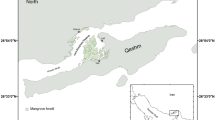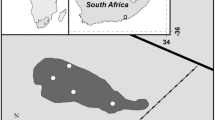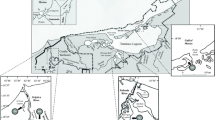Abstract
The relative importance of different organic matter sources to macrobenthic consumers was investigated at two vegetational habitats (Phragmites australis and Suaeda japonica) and at a bare intertidal flat in Suncheon Bay in May and August 2010, using stable carbon and nitrogen isotope tracers. The δ13C of consumers was much narrower in range than that of potential food sources (microphytobenthos, marsh plants, and riverine and marine particulate organic matter), and values were similar between sites. However, cluster analysis based on the consumer’s isotope values showed that they are divided according to functional groups rather than habitat type and taxonomical group, suggesting that the exploitation of different dietary sources depends on feeding strategy. Except for two suspension feeders and nonselective deposit feeders at the Phragmites bed, most consumers had similar δ13C to those of microphytobenthos. An isotopic mixing model calculation revealed the consistent importance of microphytobenthos to the nutrition of benthic invertebrates among wetland habitats in different seasons. In contrast, very little contribution of marsh plant-derived organic matter to consumer nutrition was detected at all sites. Furthermore, our results suggest that the summer monsoon event does not lead to a seasonal shift in dietary sources of consumers in this coastal wetland system.




Similar content being viewed by others
References
Anderson, M.J., R.N. Gorley, and K.R. Clarke. 2008. PERMANOVA + for PRIMER: guide to software and statistical methods. Plymouth: PRIMER-E.
Barnes, R.D. 1987. Invertebrate zoology, 5th edn. Philadelphia: Saunders College Publishing.
Bertness, M.D., and S.C. Pennings. 2002. Spatial variation in process and pattern in salt marsh plant communities in eastern north America. Concepts and Controversies in Tidal Marsh Ecology, pp 39–57
Bode, A., M.T. Alvarez-Ossorio, and M. Varela. 2006. Phytoplankton and macrophyte contributions to littoral food webs in the Galician upwelling estimated from stable isotopes. Marine Ecology Progress Series 318: 89–102.
Britton, J., and B. Morton. 1992. The ecology and feeding behaviour of Nassarius festivus (Prosobranchia: Nassariidae) from two Hong Kong bays. Proceedings of the Fourth International Marine Biological Workshop: The Marine Flora and Fauna of Hong Kong and Southern China, Hong Kong, Hong Kong University Press, pp 11–29
Brousseau, D.J., and J.A. Baglivo. 2005. Laboratory investigations of food selection by the Asian shore crab, Hemigrapsus sanguineus: algal versus animal preference. Journal of Crustacean Biology 25: 130–134.
Champman, V.J. 1960. Salt marshes and salt deserts of the world. London: Hill.
Chiba, T., and S. Sato. 2013. Size-selective predation and drillhole-site selectivity in Euspira fortunei (Gastropoda: Naticidae): implications for ecological and palaecological studies. Journal of Molluscan Studies 78: 205–212.
Choi, J.M., Y.G. Lee, and H.J. Woo. 2005. Seasonal and spatial variations of tidal flat sediments in Yeoja Bay, south coast of Korea. Journal of Korean Earth Science Society 26: 253–267.
Choy, E.J., S. An, and C.K. Kang. 2008. Pathways of organic matter through food webs of diverse habitats in the regulated Nakdong River estuary (Korea). Estuarine, Coastal and Shelf Science 78: 215–226.
Choy, E.J., P. Richard, K.R. Kim, and C.K. Kang. 2009. Quantifying the trophic base for benthic secondary production in the nakdong river estuary of Korea using stable C and N isotopes. Journal of Experimental Marine Biology and Ecology 382: 18–26.
Clarke, K.R., and R.M. Warwick. 1994. Changes in marine communities: an approach to statistical analysis and interpretation. Natural Environmental Research Council, United Kingdom, and Plymouth Marine Laboratory, Plymouth, UK
Couch, C.A. 1989. Carbon and nitrogen stable isotopes of meiobenthos and their food resources. Estuarine, Coastal and Shelf Science 28: 433–441.
Currin, C.A., S.Y. Newell, and H.W. Paerl. 1995. The role of standing dead Spartina alterniflora and benthic microalgae in salt marsh food webs: considerations based on multiple stable isotope analysis. Marine Ecology Progress Series 121: 99–116.
Currin, C.A., S.C. Wainright, K.W. Able, M.P. Weinstein, and C.M. Fuller. 2003. Determination of food web support and trophic position of the mummichong, fundulus heteroclitus, in New jersey smooth cordgrass (Spartina alterniflora), common reed (Phragmites australis), and restored salt marshes. Estuaries 26: 495–510.
Currin, C.A., L.A. Lisa, T.S. Talley, R. Michener, and D. Talley. 2011. The role of cyanobacteria in Southern California salt marsh food webs. Marine Ecology 32: 346–363.
De Jonge, V.N., and F. Colijn. 1994. Dynamics of microphytobenthos biomass in the Ems estuary measured as chlorophyll-a and carbon. Marine Ecology Progress Series 104: 185–196.
Deegan, L.A., and R.H. Garritt. 1997. Evidence for spatial variability in estuarine food webs. Marine Ecology Progress Series 147: 31–47.
DeNiro, N.J., and S. Epstein. 1979. Influence of diet on the distribution of carbon isotopes in animals. Geochimica et Cosmochimica Acta 42: 495–506.
Doi, H., M. Matsumasa, T. Toya, N. Satoh, C. Mizota, Y. Maki, and E. Kikuchi. 2005. Spatial shifts in food sources for macrozoobenthos in an estuarine ecosystem: carbon and nitrogen stable isotope analyses. Estuarine, Coastal and Shelf Science 64: 316–322.
Fauchald, K., and P.A. Jumars. 1979. The diet of worms: a study of polychaete feeding guilds. Oceanography and Marine Biology: An Annual Review 17: 193–284.
Feijtel, T.C., R.D. DeLaune, and W.H. Patrick Jr. 1985. Carbon flow in coastal Louisiana. Marine Ecology Progress Series 24: 255–260.
Fry, B., and E.B. Sherr. 1984. δ13C measurements as indicators of carbon flow in marine and freshwater ecosystems. Contributions in Marine Science 27: 13–47.
Grall, J., F. Le Loc’h, B. Guyonnet, and P. Riera. 2006. Community structure and food web based on stable isotopes (δ13C and δ15N) analysis of a North Eastern Atlantic maerl bed. Journal of Experimental Marine Biology and Ecology 338: 1–15.
Hardison, A.K., E.A. Canuel, I.C. Anderson, C.R. Tobias, B. Veuger, and M. Waters. 2013. Microphytobenthos and benthic macroalgae determines sediment organic matter composition in shallow photic sediments. Biogeosciences Discuss 10: 2791–2834.
Hong, S.Y., K.Y. Park, C.W. Park, et al. 2006. Marine invertebrates in Korean coasts. Seoul: Academy
Hong, S.K., C.H. Koh, R.R. Harris, J.E. Kim, J.S. Lee, and B.S. Ihm. 2010. Land use in Korean tidal wetlands: impacts and management strategies. Environmental Management 45: 1014–1026.
Hwang, D.W., G. Kim, Y.W. Lee, and H.S. Yang. 2005. Estimating submarine inputs of groundwater and nutrients to a coastal bay using radium isotopes. Marine Chemistry 96: 61–71.
Kang, C.K., J.B. Kim, P.Y. Lee, and J.S. Hong. 2001. The importance of intertidal benthic autotrophs to the Kwangyang Bay (Korea) food webs: δ13C analysis. Journal of the Korean Society of Oceanography 36: 109–123.
Kang, C.K., J.B. Kim, K.S. Lee, J.B. Kim, P.Y. Lee, and J.S. Hong. 2003. Trophic importance of benthic microalgae to macrozoobenthos in coastal bay systems in Korea: dual stable C and N isotope analyses. Marine Ecology Progress Series 259: 79–92.
Kang, C.K., E.J. Choy, S.K. Paik, H.J. Park, K.S. Lee, and S. An. 2007. Contributions of primary organic matter sources to macroinvertebrate production in an intertidal salt marsh (Scirpus triqueter) ecosystem. Marine Ecology Progress Series 334: 131–143.
Kim, S.G. 2010. The evolution of coastal wetland policy in developed countries and Korea. Ocean and Coastal Management 53: 562–569.
Kim, C.S., and T.G. Song. 1983. Ecological studies on the halophyte communities at western and southern coasts in Korea (IV)- The halophyte communities at the different salt marsh habitats. Korean Journal of Ecology 6: 167–176.
Koh, C.H. 2001. The Korean tidal flat: environment, biology, and human, 76–85. Seoul: Seoul National University Press.
Kon, K., Y. Hoshino, K. Kanou, D. Okazaki, S. Nakayama, and H. Kohno. 2012. Importance of allochthonous material in benthic macrofaunal community functioning in estuarine salt marshes. Estuarine, Coastal and Shelf Science 96: 236–244.
Kwak, T.J., and J.B. Zedler. 1997. Food web analysis of southern California coastal wetlands using multiple stable isotopes. Oecologia 110: 262–277.
Lefeuvre, J.C., V. Bouchard, E. Feunteun, S. Grare, P. Laffaille, and A. Radureau. 2000. European salt marshes diversity and functioning: the case study of the Mont Saint-Michel bay. France. Wetlands Ecology and Management 8: 147–161.
Leonard, L.A., and M.E. Luther. 1995. Flow hydrodynamics in tidal marsh canopies. Limnology and Oceanography 40: 1474–1484.
Levin, L.A., and T.S. Talley. 2000. Influences of vegetation and abiotic environmental factors on salt marsh invertebrates. In Concepts and controversies in tidal marsh ecology, ed. M.P. Weinstein, 661–708. Dordrecht: Kluwer.
Li, H., and S.L. Yang. 2009. Trapping effect of tidal marsh vegetation on suspended sediment, Yangtze Delta. Journal of Coastal Research 25: 915–936.
Link, J. 2002. Does food web theory work for marine ecosystems? Marine Ecology Progress Series 230: 1–9.
Mann, K.H. 1988. Production and use of detritus in various freshwater, estuarine, and coastal marine ecosystems. Limnology and Oceanography 33: 910–930.
McCutchan Jr., J.H., W.M. Lewis Jr., C. Kendall, and C.C. McGrath. 2003. Variation in trophic shift for stable isotope ratios of carbon, nitrogen, and sulphur. Oikos 102: 378–390.
McLusky, D.S. 1989. The estuarine ecosystem, 2nd ed. New York: Chapman and Hall.
Michener, R.H., and D.M. Schell. 1994. Stable isotope ratios as tracers in marine aquatic food webs. In Stable isotopes in ecology and environmental science, ed. K. Lajtha and R.H. Michener, 138–157. Oxford: Blackwell Scientific.
Moore, M.J.C., and R.A. Seigel. 2006. No place to nest or bask: effects of human disturbance on the nesting and basking habits of yellow-blotched map turtles (Graptemys flavimaculata). Biological Conservation 130: 386–393.
Moseman, S.M., L.A. Lisa, C. Currin, and C. Forder. 2004. Colonization, succession, and nutrition of macrobenthic assemblages in a restored wetland at Tijuana Estuary, California. Estuarine, Coastal and Shelf Science 60: 755–770.
Neira, C., L.A. Levin, and E.D. Grosholz. 2005. Benthic macrofaunal communities of three sites in San Francisco Bay invaded by hybrid Spartina, with comparison to uninvaded habitats. Marine Ecology Progress Series 292: 111–126.
Page, H.M. 1997. Importance of vascular plant and algal production to macro-invertebrate consumers in a southern California salt marsh. Estuarine, Coastal and Shelf Science 45: 823–834.
Park, H.J., W.C. Lee, E.J. Choy, K.S. Choi, and C.K. Kang. 2011. Reproductive cycle and gross biochemical composition of the ark shell Scapharca subcrenata (Lischke, 1869) reared on subtidal mudflats in a temperate bay of Korea. Aquaculture 321–323: 149–157.
Park, H.J., E.J. Choy, and C.K. Kang. 2013. Spatial and temporal variations of microphytobenthos on the common reed Phragmites australis bed in a marine protected area of Yeoja Bay, Korea. Wetlands 33: 737–745.
Parnell, A.C., R. Inger, S. Bearhop, and A.L. Jackson. 2010. Source partitioning using stable isotopes: coping with too much variation. PLoS ONE 5: 1–5.
Peterson, B.J., and B. Fry. 1987. Stable isotopes in ecosystem studies. Annual Review of Ecology and Systematics 18: 293–320.
Peterson, B.J., R.W. Howarth, and R.H. Garritt. 1985. Multiple stable isotopes used to trace the flow of organic matter in estuarine food webs. Science 227: 1361–1363.
Post, D.M. 2002. Using stable isotopes to estimate trophic position: models, methods, and assumptions. Ecology 83(3): 703–718.
Riera, P., L.J. Stal, J. Nieuwenhuiz, P. Richard, G. Blanchard, and F. Gentil. 1999. Determination of food sources for benthic invertebrates in a salt marsh (Aiguillon Bay, France) by carbon and nitrogen stable isotopes: importance of locally produced sources. Marine Ecology Progress Series 187: 301–307.
Shim, H.B., W.B. Cho, and B.H. Choi. 2009. Distribution of halophytes in coastal salt marsh and on sand dunes in Korea. Korean Journal of Plant Taxonomy 39: 264–276.
Sullivan, M.J., and C.A. Currin. 2000. Community structure and functional dynamics of benthic microalgae in salt marshes. In: Weinstein M.P., Kreeger D.A. (Eds), Concepts and Controversies in Tidal Marsh Ecology. Dordrecht: Kluwer
Sullivan, M.J., and C.A. Moncreiff. 1990. Edaphic algae are an important component of salt marsh food-webs: evidence from multiple stable isotope analyses. Marine Ecology Progress Series 62: 149–159.
Teal, J.M. 1962. Energy flow in the salt marsh ecosystem of Georgia. Ecology 43: 614–624.
Vander Zanden, M.J., and J.B. Rasmussen. 2001. Variation in 15 N and 13C trophic fractionation: implications for aquatic food web studies. Limnology and Oceanography 46: 2061–2066.
Wada, K. 1982. Substratum preference and feeding activity in Scopimera globasa De Haan and Ilyoplax pusillus De Haan (Crustacea Ocypodidae). Benthos Research 23: 14–26.
Wainright, S.M., M.P. Weinstein, K.W. Able, and C.A. Currin. 2000. Relative importance of benthic microalgae, phytoplankton and the detritus of smooth codgrass Spartina alterniflora and the common reed Phragmites australis to brackish-marsh food webs. Marine Ecology Progress Series 200: 77–91.
Whitcraft, C.R., and L.A. Levin. 2007. Regulation of benthic algal and animal communities by salt marsh plants: impact of shading. Ecology 88: 904–917.
Whitlatch, R.B., and S. Obrebski. 1980. Feeding selectivity and coexistence in two deposit-feeding gastropods. Marine Biology 58: 219–225.
Winemiller, K.O., S. Akin, and S.C. Zeug. 2007. Production sources and food web structure of a temperate tidal estuary: integration of dietary and stable isotope data. Marine Ecology Progress Series 343: 63–76.
Acknowledgments
This research was supported by “Long-term change of structure and function in marine ecosystems of Korea” funded by the Ministry of Oceans and Fisheries, Korea. An earlier draft of this manuscript was substantially improved thanks to the comments made by an anonymous reviewer and associate editor, Carolyn A. Currin.
Author information
Authors and Affiliations
Corresponding author
Additional information
Communicated by Carolyn A. Currin
Rights and permissions
About this article
Cite this article
Park, H.J., Kwak, J.H. & Kang, CK. Trophic Consistency of Benthic Invertebrates Among Diversified Vegetational Habitats in a Temperate Coastal Wetland of Korea as Determined by Stable Isotopes. Estuaries and Coasts 38, 599–611 (2015). https://doi.org/10.1007/s12237-014-9834-1
Received:
Revised:
Accepted:
Published:
Issue Date:
DOI: https://doi.org/10.1007/s12237-014-9834-1




